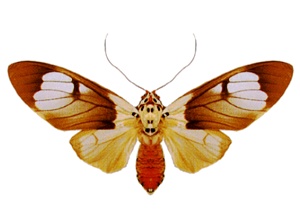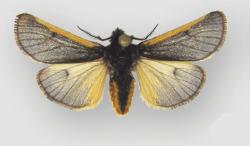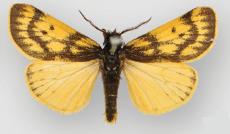
The Arctiinae are a large and diverse subfamily of moths with around 11,000 species found all over the world, including 6,000 neotropical species. This subfamily includes the groups commonly known as tiger moths, which usually have bright colours, footmen, which are usually much drabber, lichen moths, and wasp moths. Many species have "hairy" caterpillars that are popularly known as woolly bears or woolly worms. The scientific name Arctiinae refers to this hairiness. Some species within the Arctiinae have the word "tussock"' in their common names because they have been misidentified as members of the Lymantriinae subfamily based on the characteristics of the larvae.

Aemilia is a genus of tiger moths in the family Erebidae described by William Forsell Kirby in 1892. It was initially named Ameles, but this name properly refers to a praying mantis genus.

Amerila is a genus of moths in the subfamily Arctiinae. A number of species in this genus have a special defence mechanism when they are in their adult stage. When disturbed, they exude a frothy yellow fluid from glands beside the eyes, while making a sizzling noise to ward off their attacker. Similar behaviour has been observed in fertilised females of the North-American moth Utetheisa ornatrix.
Didymonyx is a genus of moths in the subfamily Arctiinae. It contains the single species Didymonyx infumata, which is found in South Africa.
Hypagoptera is a genus of moths in the subfamily Arctiinae. It contains the single species Hypagoptera rufeola, which is found in South Africa.
Leucaloa is a genus of tiger moths in the family Erebidae. The moths in the genus are found in the Afrotropics.
Micrilema is a genus of moths in the subfamily Arctiinae. It contains the single species Micrilema craushayi, which is found in Lesotho and South Africa.
Opsaroa is a genus of moths in the subfamily Arctiinae. It contains the single species Opsaroa fulvinota, which is found in South Africa.
Paradoxosia is a genus of moths in the subfamily Arctiinae. It contains the single species Paradoxosia rufipex, which is found in Uganda.
Parasiccia is a genus of moths in the subfamily Arctiinae.

Phragmatobia is a genus of moths in the subfamily Arctiinae described by James Francis Stephens in 1828. Many tiger-moth species of small and medium size were described within this genus. However, only a few are related to the type species.
Pericaliella is a genus of moths in the subfamily Arctiinae that is known from the Afrotropics. It includes one species Pericaliella melanodisca from Cameroon, Zaire, Uganda and Rwanda.
Radiarctia is a genus of moths in the family Erebidae from Afrotropics.
Pseudoradiarctia is a genus of moths in the family Erebidae from Afrotropics.

Patagobia is a monotypic moth genus in the subfamily Arctiinae erected by B. Christian Schmidt and Josef J. de Freina in 2011. Its only species, Patagobia thursbyi, was first described by Rothschild in 1910. It is found in Chile and Argentina where it is known from temperate montane woodlands and grasslands in Patagonia.

Andesobia jelskii is a species of moth of the subfamily Arctiinae first described by Charles Oberthür in 1881. It is found in the Department of Junín in Peru.

Andesobia boliviana is a species of moth of the subfamily Arctiinae first described by Max Gaede in 1923. It is found in Peru and Bolivia.

Andesobia sanguinea is a species of moth of the subfamily Arctiinae first described by George Hampson in 1907. It is found in the Lake Titicaca region of Peru and Bolivia.
Andesobia flavata is a species of moth of the subfamily Arctiinae. It is found in Peru. Only very few specimens are known, and it is closely related to or conspecific with Andesobia boliviana. Externally, the holotype of A. flavata differs from A. boliviana only in having a slightly broader and more diffuse forewing marginal band, suggestive of minor intraspecific variation. However, the genitalic structure of the holotype reveals slight differences compared to A. flavata. Additional study material is needed to properly evaluate the status of these two taxa.
Lachana alpherakii is a species of moth of the subfamily Lymantriinae first described by Grigory Grum-Grshimailo in 1891. It is found in the high mountains of Tibet and China.



